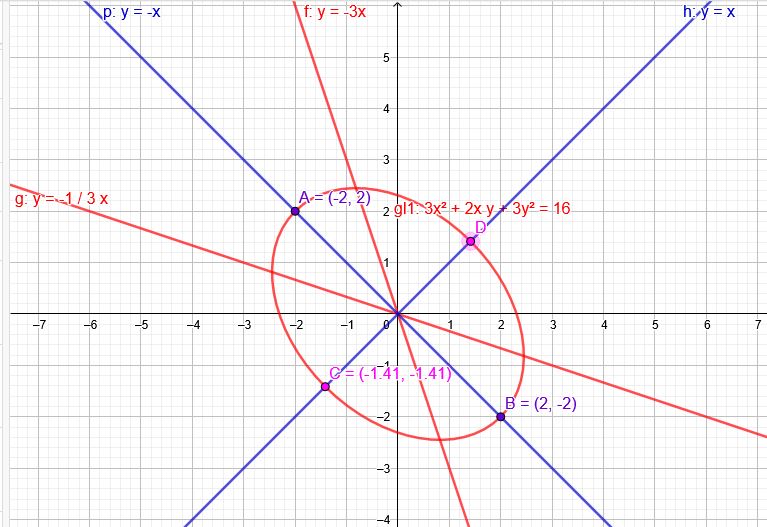\(f(x,y)=3x^2 + 2xy + 3y^2 -16 \)
\(f_x(x,y)=6x + 2y \)→ \(6x+ 2y=0 \) → \(y=-3x \) → \(m_1=-3 \)
\(f_y(x,y)=2x+6y \)→ \(2x+ 6y=0 \) → \(y=-\frac{1}{3}x \)→ \(m_2=-\frac{1}{3} \)
1. Winkelhalbierende:
\(m_1\cdot m_2=-\frac{1}{3}\cdot(-3)=1\)
\(f(x)=x\)
Schnitt mit \(3x^2 + 2xy + 3y^2 =16 \): \(8x^2 =16 \)
\(x_1=\sqrt{2}\) →\(y_1=\sqrt{2}\) Koordinate: \(D(\sqrt{2}|\sqrt{2})\)
\(x_2=-\sqrt{2}\) →\(y_2=-\sqrt{2}\) Koordinate: \(C(-\sqrt{2}|-\sqrt{2})\)
Die Punkte C und D haben Minimalabstand vom Ursprung.
Die Nebenachse hat eine Länge von \(l_1=\sqrt{(\sqrt{2})^{2}+(\sqrt{2})^{2}}=\sqrt{4}=2\)
2.) Winkelhalbierende steht senkrecht auf der 1. Winkelhalbierenden:
\(f(x)=-x\)
Schnitt mit \(3 \cdot x^2 + 2x y + 3 y^2 =16 \):
\(3 \cdot x^2 + 2x \cdot (-x) + 3\cdot (-x)^2 =16 \)
\(3 \cdot x^2 -2x^2+ 3\cdot x^2 =16 \) → \(4x^2=16 \)
\(x_1=2\) →\(y_1=-2\) Koordinate: \(B(2|-2)\)
\(x_2=-2\) →\(y_2=2\) Koordinate: \(A(-2|2)\)
Die Punkte A und B haben Maximalabstand vom Ursprung.
Die Hauptachse hat eine Länge von \(l_2=\sqrt{(-2)^2+2^2}=\sqrt{8}=2\sqrt{2}\)
Diese Ellipse ist um \(135°\) aus der Hauptlage heraus gedreht worden, wobei \(l_1<l_2\) ist.
